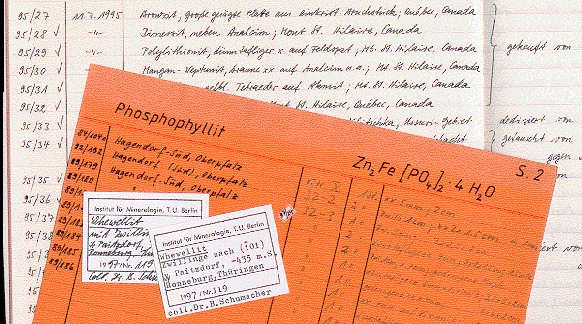| |
back
start
catalogs

mail
contact
top
of
the page
top
of
the page
top
of
the page
|
| |
"You can only work scientifically
with a well documented collection".
Geoscientific collections are archives
comparable to libraries: you can only use them appropriately with the help
of catalogs etc.
The documentation of the Mineralogical
Collections of the Technical University of Berlin consists of inventory
numbers, labels, inventory books, catalogs, scientific work and photography.
|
|
 |
.
|
inventory
numbers |
Since
the end of World War II inventory numbers read as follows: "year/piece
number", i.e., a piece with the inv.no. 95/29 has been inventorized in
the year 1995 as the 29th piece of that year.
The inventory numbers, small paper signs
of about half a cm, are sticked onto the pieces. Since 1988 they are embedded
with two component synthetic raisin, for cleaning reasons.
The inventory numbers are used uniformly
throughout the whole documentation to be able to identify the pieces definitely.
Older pieces have inventory numbers following
several numbering systems. These numbers are maintained for science history
reasons as well as to be able to assign single pieces to certain
partial collections.
|
|
labels |
Since the end of
World War II printed form labels of the TU Berlin are used in the standard
sizes of the keeping boxes.
The informations filled in contain, as
far as available:
-
mineral name (synonyms, variety name etc.)
-
if occasion arises: chemical formula according
to STRUNZ ("Mineralogical Tables")
-
remarks, descriptions (habit, paragenesis
etc.)
-
locality, as detailed as possible
-
inventory number
-
if occasion arises: origin and previous owners
of the piece
The labelling is generally done by typewriter,
since 1988 by handwriting with China ink in addition, for reasons of maintaining
the >200 years old style of the collections.
All older labels are kept carefully to
document the collection history of the piece in question. (Unfortunately,
this has not been done carefully in the past).
|
|
inventory books |
Inventorizing contains
necessarily the entry in the inventory book, with the following informations:
-
inventory number
-
inventory date
-
mineral names (varietal names etc.)
-
remarks (i.e. paragenesis, habit etc.)
-
locality, as detailed as possible
-
origin (bought/ dedicated/ changed/ collected
by, from the collection of, etc.)
-
if occasion arises: price or declaration of
value
|
|
|
Unfortunately, no inventory books are
still existing from the times before World War II, they were destroyed
during the war. |
|
catalogs |
At the moment, the total catalog of the
systematical mineralogical collection ("main collection") contains app.
2.500 mineral species, in alphabetical order of the mineral names, with
the following informations for the single pieces:
-
mineral name (synonyms)
-
crystal chemical formula according STRUNZ
-
inventory number
-
locality as detailed as possible
-
site (cupboard number - drawer number)
-
number of pieces
-
remarks (habit, varietal name, mixture name,
twinning, epitaxy, accompanying minerals, size of the piece etc.)
|
|
|
In addition, there are existing some catalogs
for partial collections and partial themes of the collections, respectively. |
|
|
further
informations |
|
|
Unfortunately, there are existing no catalogs
from the times before World War II, they were destroyed during the war. |
|
scientific research |
Supporting examination
methods as x-ray methods, microscopy and several chemical analytical methods
particularly serve mineral and phase determinations, supported by the laboratories
and machine shops of the institute.
The preparations usually are kept together
with the pieces in the collection, or in special partial collections (for
instance the collection of ore sections). They usally bear the same inventory
numbers.
|
|
photography |
Series of photographs
of the vitrines and their exhibits serve documentation purposes as well
as insurance matters. Diapositives of single pieces are kept in a special
cabinet in alphabetical order of mineral names.
Since 2006 specimens are photographed
digitally, the old diapositives have been digitalized as well. |
|

